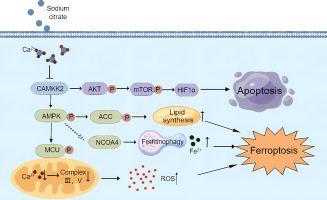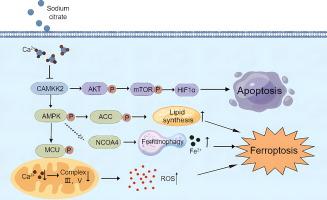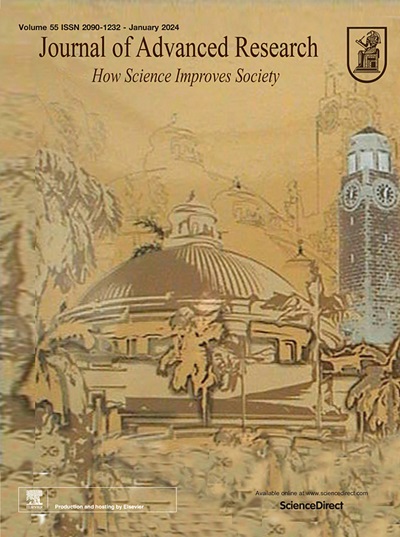以 Ca2+/CAMKK2 通路为靶点的柠檬酸钠通过诱导卵巢癌患者的细胞凋亡和铁变态表现出抗肿瘤活性。
IF 11.4
1区 综合性期刊
Q1 MULTIDISCIPLINARY SCIENCES
引用次数: 0
摘要
导言众所周知,卵巢癌(OC)的死亡率很高。尽管柠檬酸钠在多种癌症中具有抗肿瘤作用,但其在卵巢癌中的作用和机制仍不清楚:分析柠檬酸钠对卵巢癌细胞的抑制作用及其机制:方法:通过 TUNEL 染色和流式细胞仪检测细胞凋亡,并通过细胞内 Fe2+、MDA 和 LPO 检测铁变态反应。通过 OCR 和 ECAR 测量检测细胞代谢。免疫印迹和免疫沉淀被用来阐明其机制:结果:该研究表明,柠檬酸钠不仅能促进卵巢癌细胞凋亡,还能引发铁变态反应,表现为Fe2+、LPO、MDA和脂质ROS生成水平的升高。一方面,柠檬酸钠通过螯合Ca2+导致细胞质中Ca2+含量下降,进一步抑制了Ca2+/CAMKK2/AKT/mTOR信号转导,从而抑制了HIF1α依赖的糖酵解途径,诱导细胞凋亡。另一方面,柠檬酸钠对 Ca2+ 的螯合作用导致 CAMKK2 和 AMPK 失活,从而增加 NCOA4 介导的噬铁蛋白作用,引起细胞内 Fe2+ 水平升高。更重要的是,Ca2+/CAMKK2/AMPK 信号通路的抑制降低了 MCU 的活性和线粒体内的 Ca2+浓度,导致线粒体 ROS 增加。此外,代谢组学分析表明,柠檬酸钠处理显著增加了新脂质合成。总之,这些因素都导致了铁变态反应。正如预期的那样,补充 Ca2+ 成功地逆转了柠檬酸钠诱导的细胞死亡并降低了肿瘤生长。令人鼓舞的是,研究还发现,联合使用柠檬酸钠可提高 OC 细胞对化疗药物的敏感性:这些结果表明,柠檬酸钠通过抑制依赖于 Ca2+/CAMKK2 的细胞凋亡和铁凋亡来发挥其抗癌活性。柠檬酸钠有望成为治疗 OC 和提高化疗药物疗效的前瞻性化合物。本文章由计算机程序翻译,如有差异,请以英文原文为准。


Sodium citrate targeting Ca2+/CAMKK2 pathway exhibits anti-tumor activity through inducing apoptosis and ferroptosis in ovarian cancer
Introduction
Ovarian cancer (OC) is known for its high mortality rate. Although sodium citrate has anti-tumor effects in various cancers, its effect and mechanism in OC remain unclear.
Objectives
To analyze the inhibitory effect of sodium citrate on ovarian cancer cells and the underlying mechanism.
Methods
Cell apoptosis was examined by TUNEL staining, flow cytometry, and ferroptosis was examined intracellular Fe2+, MDA, LPO assays, respectively. Cell metabolism was examined by OCR and ECAR measurements. Immunoblotting and immunoprecipitation were used to elucidate the mechanism.
Results
This study suggested that sodium citrate not only promoted ovarian cancer cell apoptosis but also triggered ferroptosis, manifested as elevated levels of Fe2+, LPO, MDA and lipid ROS production. On one hand, sodium citrate treatment led to a decrease of Ca2+ content in the cytosol by chelating Ca2+, which further inhibited the Ca2+/CAMKK2/AKT/mTOR signaling, thereby suppressing HIF1α-dependent glycolysis pathway and inducing cell apoptosis. On the other hand, the chelation of Ca2+ by sodium citrate resulted in inactivation of CAMKK2 and AMPK, leading to increase of NCOA4-mediated ferritinophagy, causing increased intracellular Fe2+ levels. More importantly, the inhibition of Ca2+/CAMKK2/AMPK signaling pathway reduced the activity of the MCU and Ca2+ concentration within the mitochondria, resulting in an increase in mitochondrial ROS. Additionally, metabolomic analysis indicated that sodium citrate treatment significantly increased de novo lipid synthesis. Altogether, these factors contributed to ferroptosis. As expected, Ca2+ supplementation successfully reversed the cell death and decreased tumor growth induced by sodium citrate. Inspiringly, it was found that coadministration of sodium citrate increased the sensitivity of OC cells to chemo-drugs.
Conclusion
These results revealed that the sodium citrate exerted its anti-cancer activity by inhibiting Ca2+/CAMKK2-dependent cell apoptosis and ferroptosis. Sodium citrate will hopefully serve as a prospective compound for OC treatment and for improving the efficacy of chemo-drugs.
求助全文
通过发布文献求助,成功后即可免费获取论文全文。
去求助
来源期刊

Journal of Advanced Research
Multidisciplinary-Multidisciplinary
CiteScore
21.60
自引率
0.90%
发文量
280
审稿时长
12 weeks
期刊介绍:
Journal of Advanced Research (J. Adv. Res.) is an applied/natural sciences, peer-reviewed journal that focuses on interdisciplinary research. The journal aims to contribute to applied research and knowledge worldwide through the publication of original and high-quality research articles in the fields of Medicine, Pharmaceutical Sciences, Dentistry, Physical Therapy, Veterinary Medicine, and Basic and Biological Sciences.
The following abstracting and indexing services cover the Journal of Advanced Research: PubMed/Medline, Essential Science Indicators, Web of Science, Scopus, PubMed Central, PubMed, Science Citation Index Expanded, Directory of Open Access Journals (DOAJ), and INSPEC.
 求助内容:
求助内容: 应助结果提醒方式:
应助结果提醒方式:


